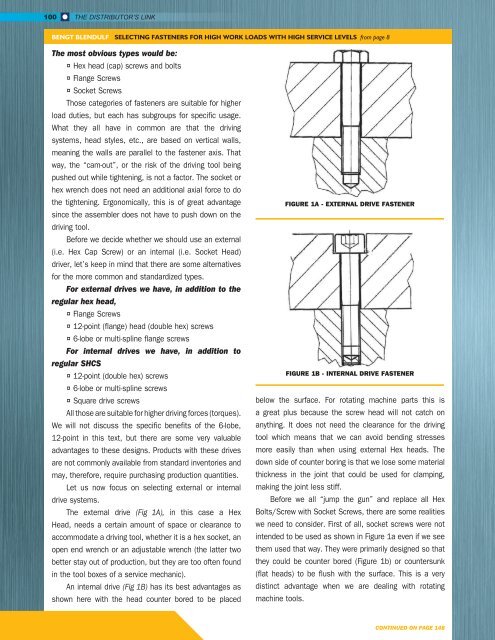SPRING 2018
Distributor's Link Magazine Spring 2018 / Vol 41 No2
Distributor's Link Magazine Spring 2018 / Vol 41 No2
You also want an ePaper? Increase the reach of your titles
YUMPU automatically turns print PDFs into web optimized ePapers that Google loves.
100<br />
THE DISTRIBUTOR’S LINK<br />
BENGT BLENDULF SELECTING FASTENERS FOR HIGH WORK LOADS WITH HIGH SERVICE LEVELS from page 8<br />
The most obvious types would be:<br />
¤ Hex head (cap) screws and bolts<br />
¤ Flange Screws<br />
¤ Socket Screws<br />
Those categories of fasteners are suitable for higher<br />
load duties, but each has subgroups for specific usage.<br />
What they all have in common are that the driving<br />
systems, head styles, etc., are based on vertical walls,<br />
meaning the walls are parallel to the fastener axis. That<br />
way, the “cam-out”, or the risk of the driving tool being<br />
pushed out while tightening, is not a factor. The socket or<br />
hex wrench does not need an additional axial force to do<br />
the tightening. Ergonomically, this is of great advantage<br />
since the assembler does not have to push down on the<br />
driving tool.<br />
Before we decide whether we should use an external<br />
(i.e. Hex Cap Screw) or an internal (i.e. Socket Head)<br />
driver, let’s keep in mind that there are some alternatives<br />
for the more common and standardized types.<br />
For external drives we have, in addition to the<br />
regular hex head,<br />
¤ Flange Screws<br />
¤ 12-point (flange) head (double hex) screws<br />
¤ 6-lobe or multi-spline flange screws<br />
For internal drives we have, in addition to<br />
regular SHCS<br />
¤ 12-point (double hex) screws<br />
¤ 6-lobe or multi-spline screws<br />
¤ Square drive screws<br />
All those are suitable for higher driving forces (torques).<br />
We will not discuss the specific benefits of the 6-lobe,<br />
12-point in this text, but there are some very valuable<br />
advantages to these designs. Products with these drives<br />
are not commonly available from standard inventories and<br />
may, therefore, require purchasing production quantities.<br />
Let us now focus on selecting external or internal<br />
drive systems.<br />
The external drive (Fig 1A), in this case a Hex<br />
Head, needs a certain amount of space or clearance to<br />
accommodate a driving tool, whether it is a hex socket, an<br />
open end wrench or an adjustable wrench (the latter two<br />
better stay out of production, but they are too often found<br />
in the tool boxes of a service mechanic).<br />
An internal drive (Fig 1B) has its best advantages as<br />
shown here with the head counter bored to be placed<br />
FIGURE 1A - EXTERNAL DRIVE FASTENER<br />
FIGURE 1B - INTERNAL DRIVE FASTENER<br />
below the surface. For rotating machine parts this is<br />
a great plus because the screw head will not catch on<br />
anything. It does not need the clearance for the driving<br />
tool which means that we can avoid bending stresses<br />
more easily than when using external Hex heads. The<br />
down side of counter boring is that we lose some material<br />
thickness in the joint that could be used for clamping,<br />
making the joint less stiff.<br />
Before we all “jump the gun” and replace all Hex<br />
Bolts/Screw with Socket Screws, there are some realities<br />
we need to consider. First of all, socket screws were not<br />
intended to be used as shown in Figure 1a even if we see<br />
them used that way. They were primarily designed so that<br />
they could be counter bored (Figure 1b) or countersunk<br />
(flat heads) to be flush with the surface. This is a very<br />
distinct advantage when we are dealing with rotating<br />
machine tools.<br />
CONTINUED ON PAGE 148

















